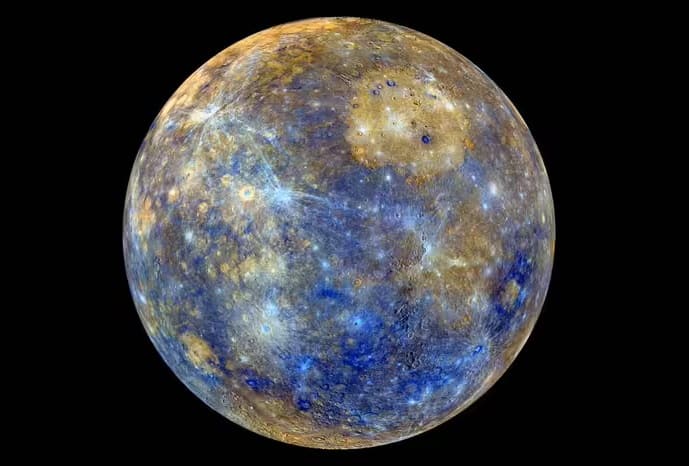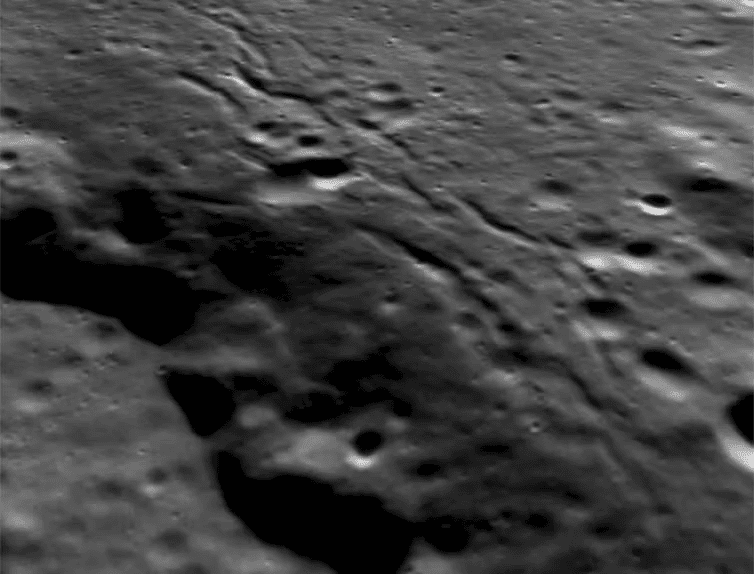Mercury, the closest planet to the Sun, has always fascinated astronomers and planetary scientists. This small, rocky world has an intriguing history, and a very puzzling characteristic: it’s apparently shrinking.
At the heart of Mercury’s mystery lies its cooling core. Despite its proximity to the Sun, the planet’s interior has been gradually cooling down over the eons. This cooling has big implications for Mercury’s geological evolution.
As the planet cools, the rock and metal that compose Mercury contract slightly in volume. This thermal contraction results in a curious phenomenon – the planet’s surface, or crust, begins to respond by forming what scientists call “thrust faults.” These faults manifest Mercury’s ongoing transformation due to its cooling core.
The first hints of shrinkage came in 1974 when NASA’s Mariner 10 mission sent back images of scarps, or ramp-like slopes, stretching across the planet’s terrain. These scarps, which came to be known as “lobate scarps,” soared to heights of kilometers and extended hundreds of kilometers across the surface. They were the first tangible signs of Mercury’s geological restlessness.
Subsequently, the Messenger spacecraft, which orbited Mercury from 2011 to 2015, provided even more insights. It revealed the presence of numerous lobate scarps scattered throughout the planet, reaffirming the notion that Mercury was indeed shrinking.
Understanding the age of these scarps is crucial in deciphering the chronicles of Mercury’s geological history and predicting its future. To date them, scientists employ a method rooted in the density of impact craters. The more craters on a surface, the older it is since it has been exposed to cosmic collisions for longer periods.
However, this approach is not without challenges. The early Solar System was a far more chaotic place in its earlier stages, with a higher rate of impacts than today. This means that the number of craters alone cannot provide a precise age, though most believe Mercury’s scarps to hover around three billion years old.
Nonetheless, one critical clue emerges from these scarps’ complex relationships with impact craters. While some scarps cut through older craters, younger craters often overlap with them. This suggests that the scarps could predate the younger craters.
A pivotal question remains: did these scarps cease their movements long ago, or are they still active, gradually changing the face of Mercury? The answer lies in understanding the dynamics of the thrust faults beneath them.
Earthquakes offer an analogy. The magnitude 9 Tohoku earthquake off the coast of Japan in 2011 resulted from a sudden 20-meter jump along a 100-kilometer-long thrust fault. On Mercury, the scale of these “earthquakes” (or rather, mercuryquakes) is likely smaller, given the planet’s size. Accumulating the two to three kilometers of total shortening observed across a typical scarp on Mercury would require hundreds of magnitude 9 quakes or potentially millions of smaller events. These events could have unfolded over billions of years.
Until recently, evidence regarding the scale and duration of fault movements on Mercury remained scarce. However, a breakthrough emerged when Open University Ph.D. student Ben Man noticed an intriguing feature. Some scarps exhibited small fractures on their stretched upper surfaces, interpreted as “grabens” – strips of ground that have dropped between two parallel faults.
Published in Nature Geoscience, this discovery hinted at a possible mechanism for the formation of these grabens. While the overall crust of Mercury was undergoing compression, individual thrust slices of crust could bend as they were pushed over adjacent terrain, resulting in the formation of grabens.
The grabens are relatively small, less than one kilometer wide and less than about 100 meters deep. These features must be much more recent than the ancient structures they rest upon, or else the impact gardening bombardment of cosmic debris would have erased them.
By studying the rate at which impact gardening blurs surface features, scientists estimated that the majority of grabens are less than about 300 million years old. This suggests that their latest movements must have occurred quite recently on geological timescales.
Man’s research, conducted with the help of Messenger’s detailed images, identified 48 large lobate scarps definitively associated with small grabens and an additional 244 scarps with “probable” grabens – not clearly visible in the images. These findings open a new chapter in understanding Mercury’s ongoing geological activity.
The joint European/Japanese BepiColombo mission, set to begin operations in orbit around Mercury in 2026, now has some prime targets for its exploration.
While BepiColombo won’t land on Mercury’s surface or provide seismic data, it will offer a closer look at these grabens and other surface features, potentially revealing boulder tracks, the footprints of recent Mercuryquakes. Such evidence could provide additional clues about the innermost planet’s geological activity, further unraveling the secrets of our enigmatic neighbor.











